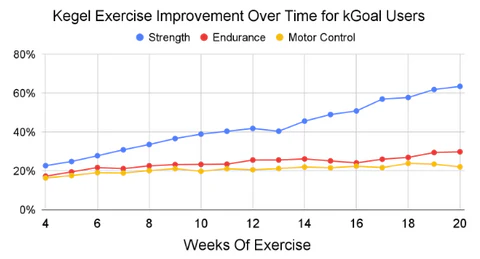How Long Does It Take For Kegels To Start Working?
Published October 11, 2025

One of the most common questions for any type of exercise is “when will I see results?” – or perhaps to channel our inner 5 year old: “are we there yet???” Kegel exercise (aka pelvic floor strengthening exercise) is no exception. Actually, if anything the normal progress arc for Kegels is more of a mystery than with many other types of exercise because (1) most people aren’t very familiar with the pelvic floor and (2) it can be hard to tell if the muscles are getting fitter (you can’t see them, and it’s not like there is a mile time or weight lifting measurement you can use to assess performance on your own).
Well, we’re here to clear up the mystery. So, read on to learn much more about how often you should do Kegels, when you can expect to make progress and see results, and a few tips that might help accelerate the process (or, you can skip ahead to the end for the quick summary)!
(The flip side of this same coin is downtraining, which means practicing relaxing your pelvic floor muscles if you have an overactive pelvic floor (you may have also seen this described as high tone or hypertonic), which is often characterized by pelvic pain. Downtraining is basically the opposite of Kegel exercise, and we’ll be publishing a companion article on how long it can take for downtraining to take effect soon).
How Often Should You Do Kegels?
You can’t even really guess when results will come without first knowing how often you’re exercising – if you exercise once a month, the outcome will be very different than if you’re exercising every day. So that is a key piece of information to have in place right from the start.
Many pelvic floor physical therapists recommend:
- 5-10 minutes of Kegel exercise per session, making sure to include short rests during the session and a 2 minute rest in the middle if you’re doing 10 minutes total. More generally, it’s important not to exercise to true fatigue – once you’ve lost about 50% of your strength/power, it’s time to stop for that session
- Exercising at least 5 days per week is good (although every day is preferable)
- For the super overachievers, you can consider as many as three sessions per day (ideally split apart significantly – for instance morning, midday and evening). Any more than that starts to run a risk of overtraining, which can cause your pelvic floor to become overactive and can cause pelvic pain or other problems. And you should always listen to your body – if you feel like you’re overtraining, you probably are
Because ~5 minutes, 5x per week is a common recommendation from health care practitioners, that’s the approximate exercise schedule we’re basing this article on. But just know that if you can stick with a routine where you’re exercising more frequently than that, you’re likely to see results more quickly and conversely if you can’t quite get yourself to that frequency of exercise, it may be more of a slower process.
When Might You See Results?
The technically true but boring (and pretty useless) answer is: “it depends”. That is no surprise – no two fitness or health journeys are completely identical. But it’s still possible (and helpful!) to lay out a few general rules of thumb and common expectations, even if your experience might vary in one direction or the other.
There are a few ways to approach the question. We’re going to look at data from three types of sources to try to provide a well-rounded ballpark of reasonable expectations across a variety of different scenarios.
- Ask a pro (a pelvic floor physical therapist)
- Check the medical literature
- See what actual exercise data from real people shows us
What do pelvic floor physical therapists say?
First, we asked Liz Miracle, who is a pelvic floor physical therapist and the head of clinical quality and education for Origin, the largest in-network provider of pelvic floor physical therapy in the US. She said that, although a fair amount of variation is very normal, she typically tells patients that they should see some results within 2 months (again, assuming they are exercising 5-7 times per week as mentioned above).
What does the medical literature say?
There is also a deep body of medical literature available that looks at the effects of pelvic floor exercise for both women and men in a variety of contexts. Looking at the exercise protocols used in those studies can give some hints as to how long the study designers expected it to take for the subjects to see results (in general, they try to avoid giving the participants an exercise regimen that they think is either too short to do anything useful or unnecessarily long). Here are a few interesting papers with both the exercise protocols they used, and the results they found:
- This study found that 6 weeks of pelvic floor exercise was effective at preventing stress urinary incontinence during pregnancy
- This study found that doing pelvic floor exercise with biofeedback 3 times per week for 8 weeks was effective in improving stress urinary incontinence in women more generally
- This study found that as little as 1-2 weeks of Kegel exercise could enhance both physiological and subjective measures of sexual arousal for women
- This study found that a 12-week regimen of pelvic floor exercise significantly improved sexual stamina for men struggling with premature ejaculation
- This study found that a 12-week regimen of pelvic floor exercise with biofeedback significantly improved erectile function for men with ED
- This study found that biofeedback pelvic floor training for 12 weeks speeds recovery of urinary continence after radical prostatectomy, and the improvements tend to last for at least 12 months after the surgery
What about exercise data from real people?
Lastly, we looked at anonymized user exercise data from thousands of actual people who have been using our kGoal Classic or Boost sit-on-top Kegel trainers (Boost can be used by both men and women). They are designed to help users stick with a more consistent (and fun!) exercise routine by providing biofeedback, exercise measurement and progress tracking, and guided workouts / games like Pinball.
Our user base includes a wide variety of people across genders and ages / phases of life, from early 20s up through 80+. The data we’re sharing here comes from a diverse sample of nearly 2,000 of those people to try to provide a generalized baseline of results.
There are three aspects of pelvic floor muscle function that our trainers focus on with the recommended games/workouts: (1) Strength, (2) Endurance, and (3) Motor Control. For this data set, we focused on people who were exercising fairly consistently and avoided gaps of more than 7 days between workouts. Because our products are exercise tools and not medical devices, we focus on % improvement in muscle performance but don’t attempt to quantify how those changes are connected to clinical outcomes regarding pelvic floor-related dysfunctions like urinary incontinence, pelvic organ prolapse, erectile dysfunction, or premature ejaculation.
So, with all that context out of the way, let’s get to the interesting part. Here is a plot showing how much the average user improved their pelvic floor muscle Strength, Endurance and Motor Control after a given amount of time with their Kegel exercise routine:
A few conclusions:
- Improvements start coming pretty early – most people see around 20% improvement in each domain of muscle function within the first month or so
- The implication from the clinical study protocols is that 12 weeks should be sufficient for most people to achieve meaningful improvements. However, our data suggests that for Strength (and to a lesser extent Endurance), continued gains are available even beyond that 12-week / 3-month milestone. On the other hand, most of the Motor Control improvements are accomplished within the first month or so
Putting it all together...
Up above we promised three ways of answering the question of “how long do you have to do Kegel exercises before you see results?” and the good news is that all 3 approaches point in the same direction.
Whether it’s based on advice from a health care provider, the implications from a clinical study protocol, or exercise results from a large data set of real Kegel exercisers, an approximate rule of thumb is that many people often start seeing results as quickly as within the first month. And from there, continuing a consistent exercise routine for at least 3 months total (12 weeks) is quite likely to result in measurable and noticeable improvements in pelvic floor muscle performance and function.
Obviously there are a number of factors that can influence the situation, including age, the exact details of your exercise regimen, initial severity of any pelvic floor dysfunction present when you start, and other considerations. But as a starting point for expectations, this should be the right ballpark.
Is There Any Way To Speed Things Up?
The short answer is: Yes!
The first tip is quite simple. As with basically every type of physical exercise, exercising more / more consistently = faster progress (up to a point – also as with other types of exercise, it is definitely possible to overtrain your pelvic floor muscles. This can result in your pelvic floor becoming overactive, which can cause pelvic pain or other unpleasant side effects. As mentioned above, many pelvic floor PTs recommend not exercising more than 5-10 minutes per session and at the very most 3 sessions per day. But everyone is different, so be sure to listen to your body and slow things down if your pelvic floor muscles start feeling painful or unduly sore).
Another option is to start integrating more functional movements into your workout routine. Doing Kegels while you’re lying or sitting down is great, especially if you’re getting started and need to really focus to make sure you’re maintaining proper technique. But as you get more comfortable and confident with the exercise, doing Kegels while you’re moving your body in other ways can really help you level things up. Examples include standing, walking, climbing up/down stairs, or doing squats or lunges while you’re Kegeling.
However, there are no magic tricks – at the end of the day, what you get out of pelvic floor exercise (and any other exercise) pretty much depends on what you put into it.
The Bottom Line
Everybody (and every body) is different and so there’s no singular “everyone sees results from Kegel exercise after X weeks” answer. But with that said…
- It is not uncommon (but also not universal) to see pelvic floor muscle function start to improve within the first month of a consistent exercise regimen
- Sticking with a good routine for a total of 2-3 months generally results in meaningful improvements (although, as with any exercise, if you totally quit after that it’s likely your muscles will regress over time – so an ongoing maintenance fitness routine is always a good idea). Using a Kegel trainer like kGoal Classic (for women) or the Boost sit-on-top Kegel trainer (for men and women) can help keep you on track with your exercise goals and provide feedback along the way.
- Furthermore, continuing the exercise routine beyond 3 months generally continues to yield improvements in muscle performance, especially in terms of pelvic floor muscle strength and, to a lesser extent, endurance
Hopefully this comes as good news – a few months is really not that long to stick with a Kegel routine considering the quality of life improvements that can be unlocked by a healthy pelvic floor. Happy Kegeling!













